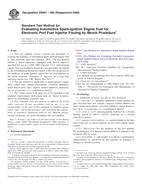Potřebujeme váš souhlas k využití jednotlivých dat, aby se vám mimo jiné mohly ukazovat informace týkající se vašich zájmů. Souhlas udělíte kliknutím na tlačítko „OK“.
ASTM D6421-99a(2009)
Standard Test Method for Evaluating Automotive Spark-Ignition Engine Fuel for Electronic Port Fuel Injector Fouling by Bench Procedure (Includes all amendments And changes 11/17/2014).
Automaticky přeložený název:
Standardní zkušební metody pro hodnocení Automotive zážehového motoru Palivo pro elektronické Port Fuel Injector Znečištění by Bench řádu
NORMA vydána dne 1.6.2009
Informace o normě:
Označení normy: ASTM D6421-99a(2009)
Poznámka: NEPLATNÁ
Datum vydání normy: 1.6.2009
Kód zboží: NS-35081
Počet stran: 9
Přibližná hmotnost: 27 g (0.06 liber)
Země: Americká technická norma
Kategorie: Technické normy ASTM
Anotace textu normy ASTM D6421-99a(2009) :
Keywords:
base fuel, bench test, deposit control additive, deposits (in internal combustion engines), electronic port fuel injector (PFI), flow rate, hot soak, injector fouling, pintle, spark-ignition engine fuel, test fuel, Automotive engine fuels/oils, Base fuel, Bench test, Bosch injectors, Deposit (internal combustion engine) formation, Electronic port fuel injector (PFI), Flow and flow rate--petroleum products, Hot soak, Injector fouling, Pintle
Doplňující informace
| Significance and Use | ||||||||||
|
Driveability problems in PFI automobiles were first reported in 1984. Deposits are prone to form on the metering surfaces of pintle-type electronic fuel injectors. These deposits reduce fuel flow through the metering orifices. Reductions in metered fuel flow result in an upset in the air-fuel ratio, which can affect emissions and driveability. When heavy enough, these deposits can lead to driveability symptoms, such as hesitation, hard starting, or loss of power, or a combination thereof, that are easily noticed by the average driver and that lead to customer complaints. The mechanism of the formation of deposits is not completely understood. It is believed to be influenced by many factors, including driving cycle, engine and injector design, and composition of the fuel. The procedure in this test method has been found to build deposits in PFIs on a consistent basis. This procedure can be used to evaluate differences in base fuels and fuel additives. A study of PFI fouling was conducted in both the bench test and the vehicle test procedures to obtain a correlation. The vehicle tests were conducted as described in Test Method D5598. The tests were conducted on several base gasolines, with and without additives blended into these base fuels. The PFI bench test proved to be reliable, repeatable, and a good predictor of PFI fouling in test vehicles. State and Federal Legislative and Regulatory Action—Legislative and regulatory activity, primarily by the state of California (see 2.3) and the federal government (see 2.4), necessitate the acceptance of a standard test method to evaluate the PFI deposit-forming tendency of an automotive spark-ignition engine fuel. Relevance of Results—The operating conditions and design of the laboratory apparatus used in this test method may not be representative of a current vehicle fuel system. These factors must be considered when interpreting results. Test Validity: Procedural Compliance—The test results are not considered valid unless the test is completed in compliance with all requirements of this test method. Deviations from the parameter limits presented in Section 10 will result in an invalid test. Engineering judgment shall be applied during conduct of the test method when assessing any anomalies to ensure validity of the test results. |
||||||||||
| 1. Scope | ||||||||||
|
1.1 This test method covers a bench test procedure to evaluate the tendency of automotive spark-ignition engine fuel to foul electronic port fuel injectors (PFI). The test method utilizes a bench apparatus equipped with Bosch injectors specified for use in a 1985-1987 Chrysler 2.2-L turbocharged engine. This test method is based on a test procedure developed by the Coordinating Research Council (CRC) for prediction of the tendency of spark-ignition engine fuel to form deposits in the small metering clearances of injectors in a port fuel injection engine (see CRC Report No. 592). 1.2 The test method is applicable to spark-ignition engine fuels, which may contain antioxidants, corrosion inhibitors, metal deactivators, dyes, deposit control additives, demulsifiers, or oxygenates, or a combination thereof. 1.3 The values stated in SI units are to be regarded as the standard. Approximate inch-pound units are shown in parentheses for information purposes only. 1.4 This standard does not purport to address all of the safety concerns, if any, associated with its use. It is the responsibility of the user of this standard to establish appropriate safety and health practices and determine the applicability of regulatory limitations prior to use. Specific precautionary statements are given throughout this test method. Note 1—If there is any doubt as to the latest edition of Test Method D6421, contact ASTM International Headquarters. Other properties of significance to spark-ignition engine fuel are described in Specification D4814. |
||||||||||
| 2. Referenced Documents | ||||||||||
|




 Cookies
Cookies
